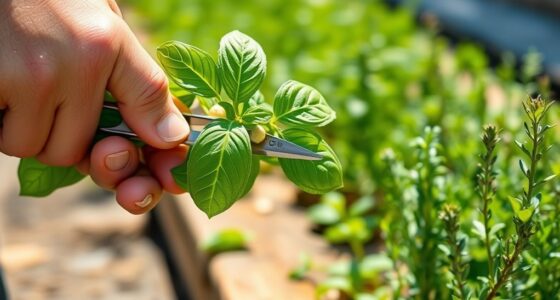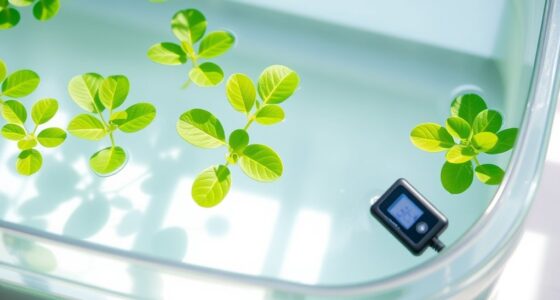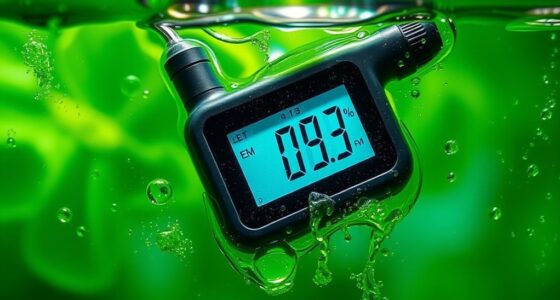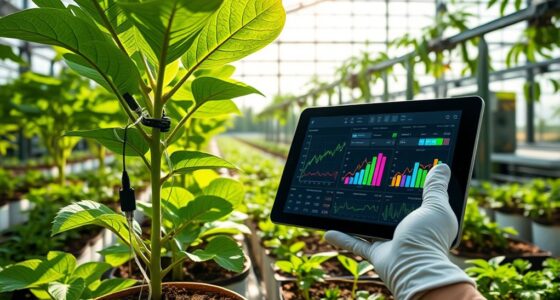To replace tubing and fittings in your hydroponic system, start by turning off the system and draining any residual water. Carefully disconnect old hoses and fittings, then measure and secure new ones tightly without over-tightening. Regularly inspect for cracks, leaks, or buildup, and swap out parts when needed to maintain smooth flow and prevent clogs. Continuing with proper maintenance guarantees your plants stay healthy and your system runs efficiently.
Key Takeaways
- Turn off the system, drain residual water, and carefully disconnect old tubing from pumps and fittings before replacement.
- Measure and cut new tubing accurately; secure fittings tightly without over-tightening to prevent damage.
- Regularly inspect tubing and fittings for cracks, leaks, or mineral buildup to determine when replacements are needed.
- Use clamps or quick-connect fittings for easier future maintenance and secure connections.
- Performing routine replacements maintains water flow, prevents leaks, and ensures optimal nutrient delivery for healthy plant growth.
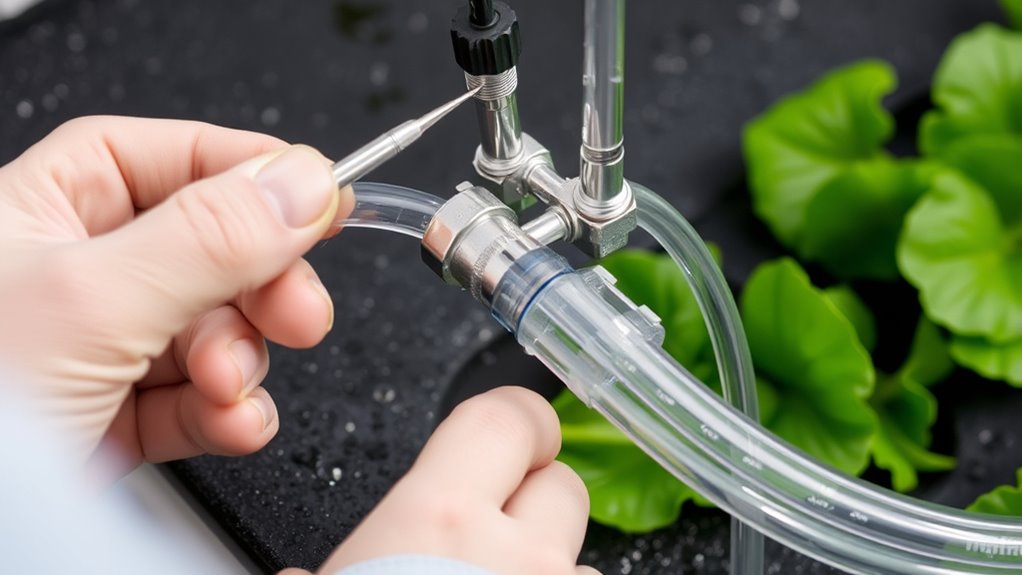
Replacing tubing and fittings in your hydroponic system is fundamental for maintaining ideal water flow and preventing clogs or leaks. When you keep these components in top condition, you guarantee your system functions smoothly, which directly impacts how effectively your plants receive nutrients. Proper pump maintenance plays an indispensable role here because a well-maintained pump guarantees consistent water circulation, reducing the chances of blockages caused by debris or mineral buildup in the lines. If your pump isn’t working efficiently, nutrients won’t reach your plants evenly, leading to uneven growth or deficiencies. Regularly inspecting and replacing worn tubing and fittings helps keep your pump operating at peak performance, ensuring steady nutrient delivery.
Regularly replacing tubing and fittings ensures smooth water flow and optimal nutrient delivery in your hydroponic system.
Over time, tubing can develop cracks, become brittle, or accumulate algae and mineral deposits, which compromises water flow. When you notice reduced flow rates or inconsistent watering, it’s time to replace those sections. Fittings can also loosen or crack, causing leaks that waste water and nutrients or introduce pathogens. Replacing these fittings ensures a secure, leak-free connection, which is indispensable for maintaining the right environment for your plants. Using high-quality, food-grade tubing and fittings minimizes the risk of chemical leaching and contamination, maintaining the purity of your nutrient solution.
When you go to replace tubing, start by turning off your system and draining any residual water. Carefully disconnect the old tubing from pumps, emitters, and other fittings. Make sure to measure the length of new tubing accurately to avoid excess slack or tight bends that could restrict flow. When installing new fittings, ensure they are tightly secured but not over-tightened, as this can cause damage or make future replacements more difficult. Use clamps or quick-connect fittings to make future maintenance easier, and verify all connections are airtight and watertight before restarting your system.
Regularly replacing worn or damaged tubing and fittings not only safeguards your nutrient delivery system but also reduces maintenance time and costs in the long run. Keep an eye on the condition of your components, and don’t wait until leaks or flow issues become apparent. Staying proactive helps prevent more serious problems, such as pump failure or root diseases caused by stagnant or contaminated water. Ultimately, investing time in maintaining and replacing these parts ensures your hydroponic system continues to operate efficiently, providing your plants with a steady, reliable supply of nutrients for healthy growth.
Frequently Asked Questions
How Often Should I Replace Tubing in My Hydroponic System?
You should replace your hydroponic tubing every 6 to 12 months, depending on tubing material considerations like UV resistance and chemical compatibility. Regularly inspect for cracks, discoloration, or buildup, which indicate it’s time for a swap. Follow replacement scheduling tips to maintain system efficiency and prevent clogs or contamination. Using durable, food-grade tubing can extend its lifespan, but proactive replacement guarantees your plants stay healthy and your system runs smoothly.
What Tools Are Best for Removing Old Fittings?
You should use a wrench or pliers to remove old fittings, ensuring you choose tools compatible with the fitting size and type to prevent damage. Always prioritize tool safety by wearing gloves and eye protection, and work carefully to avoid slipping or breaking fittings. Proper fitting compatibility helps you avoid unnecessary force, making removal smoother and safer. Remember, using the right tools minimizes damage and keeps your hydroponic system running efficiently.
Can I Reuse Fittings After Cleaning?
Sure, you can reuse fittings after cleaning, but don’t get too excited. While cleaning techniques like soaking in vinegar or using brushes work, material compatibility is key—some fittings may degrade or harbor bacteria. Think twice before reusing, as compromised fittings can cause leaks or contamination, risking your entire system. To keep things safe and efficient, it’s often better to replace fittings rather than risking future issues.
How Do I Identify Leaks After Replacing Tubing?
To identify leaks after replacing tubing, perform leak detection by visually inspecting all connections for drips or wet spots. Run the system and listen for hissing sounds that indicate escaping air or water. Check the seal integrity around fittings by gently feeling for moisture or pressure drops. If you notice any signs, tighten fittings or reapply sealant as needed to make certain a secure, leak-free system.
Are There Eco-Friendly Options for Replacement Parts?
Are eco-friendly options available for replacement parts? Yes, you can choose biodegradable plastics and eco-friendly adhesives to make your hydroponic system more sustainable. These materials break down naturally, reducing environmental impact. Have you considered using biodegradable tubing or fittings? They’re durable yet eco-conscious choices that help you maintain your system’s efficiency while caring for the planet. Switching to these options makes your setup greener without sacrificing performance.
Conclusion
Regularly replacing tubing and fittings in your hydroponic system keeps everything running smoothly and prevents clogs. Did you know that outdated or clogged tubing can reduce nutrient flow by up to 30%, impacting your plants’ growth? By staying on top of maintenance, you’ll guarantee your system stays efficient and your plants thrive. Don’t wait for problems to arise—routine replacements are a simple step toward healthier, more productive hydroponic gardening.

